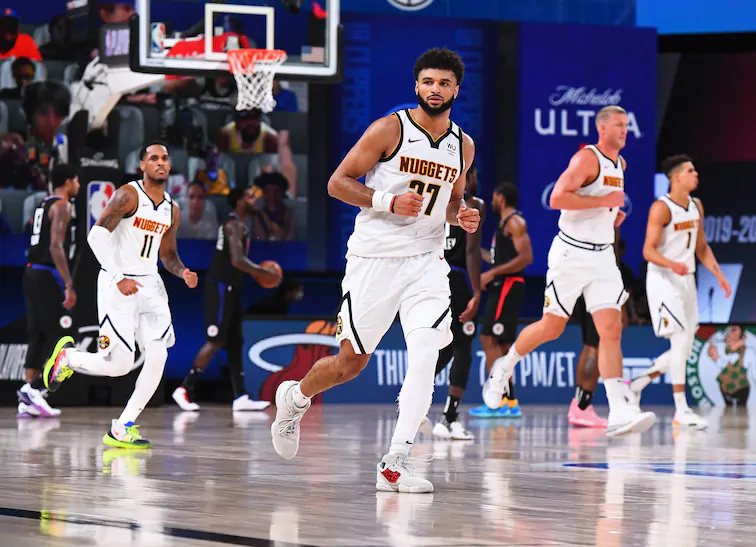
Lakers-Nuggets Scouting Report
Round 3! By now, you know the drill. We’re going to cover how Denver’s offense works, how we’d want to slow it down, and what vulnerabilities their defense has for LA to exploit.
Denver’s Top Actions
Here are the actions that have been used most frequently by Denver this postseason. Shown are their scoring attempts per game, the percentage of the league their efficiency is higher than during the playoffs for that play type, and in parentheses, their full-year percentile.
- 9.6: Murray P&R; 86th percentile (73rd)
- 5.4: Jokic Roll Man; 43rd percentile (43rd)
- 4.8: Jokic Post Up; 46th percentile (84th)
- 4.3: Grant Spot Up; 16th percentile (59th)
- 3.9: Porter Spot Up; 52nd percentile (83rd)
- 3.6: Jokic Spot Up; 65th percentile (55th)
- 3.6: Murray Handoff; 86th percentile (64th)
- 3.4: Morris P&R; 43rd percentile (67th)
- 2.7: Murray Isolation; 95th percentile (80th)
- 2.4: Millsap Spot Up; 35th percentile (82nd)
I’ve bolded the 5 actions that are primary forms of offense. The unbolded actions are usually the result of those primary actions breaking the defense down and kicking out or dumping off to players in those unbolded secondary actions.
Jamal Murray Pick & Roll
What makes Jamal Murray so effective in the pick and roll is his combined scoring ability and IQ. For a lot of guards, there’s a clear coverage you’d want to run to push them toward an area of their game they’re less effective with or conceding a potential advantage you know is outside their skill set.
For example, you can play drop coverage against CJ McCollum or Russell Westbrook, based on their skill sets and tendencies. You can go under Rajon Rondo screens altogether while dropping, because he’s not someone that’ll hurt you with pull ups to an even higher (lower?) degree.
But Murray is a dynamic guard, able to get to the rim and score, hit mid range pull ups, hit 3-point pull ups, and string out hedges to create switches then attack in iso. Tactics are a lot of “if this, then that,” and Murray has these nailed down fairly well.
Here’s a look at Murray’s shot chart from the pick & roll in the playoffs so far:
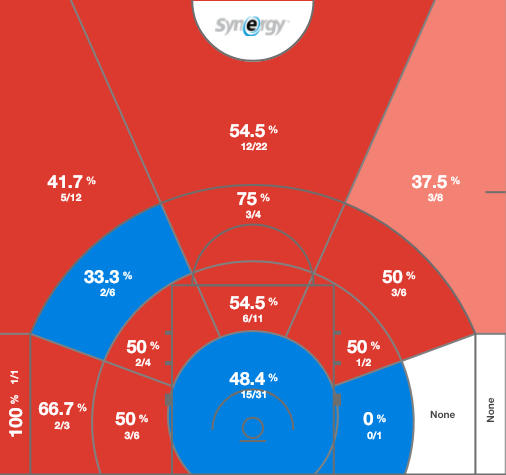
The Lakers have faced guards like this in the playoffs. In the first round, Dame Lillard presented a similar challenge to the Laker defense. As someone shooting 5.8 pull-up 3-pointers per game in the playoffs and making them at a 44% clip, he wasn’t someone you could play drop coverage against.
LA responded by deciding to hard hedge, which took away his ability to shoot pull-up 3s or start attacking downhill, but conceded pops and short rolls to the screener all series. “Make someone else beat us” is a simple way to put the idea behind this execution, and it can be the right move if the opposing team can’t effectively score in 4 on 3 scenarios or take advantage of the open pops you willingly give up.
In a way, LA’s coverage of James Harden with trapping in round two was also similar. It wasn’t always from the pick and roll, but the Laker defense dared Houston to beat them 4 on 3.
In both of those cases, LA faced offenses that couldn’t win in those temporary power play situations. In round 1, this was due to a combination of Nurkic’s inability as a creator off the dribble, popper, and because Nurkic couldn’t process his decisions quickly enough to be anywhere near the passer he is in other playmaking situations. In round 2, Houston’s players standing around without any cutting or screening allowed these 4 on 3s to be effective.
In both scenarios, the opposing coaching staffs had clear opportunities to adjust to this tactic through simple Xs and Os well within their personnels’ talent levels, as I covered here for Portland and here for Houston. But they didn’t.
Denver presents a different challenge. Jamal Murray has shot 5.3 pull-up 3-pointers per game in the playoffs so far, 5th highest among playoff participants and only 0.5 per game less than Dame. Murray has also made them 49% of the time, which is an insane number that likely won’t continue. 65% of his pull up 3s come from the pick and roll (that number was ~75% for Dame), so taking those away seems to be key to slowing down his scoring.
For extra context, in the regular season he made 1.0 of the 3.0 he attempted per game in the regular season, a far more pedestrian number. Here’s more info on how insanely well Murray has been making shots this postseason:
SHOTMAKING:
Jamal Murray rolling 10-game averages of eFG% above expected (from shot quality), and then total shot quality and eFG%
* +0.8% in the regular season
* +9.8% in the playoffs pic.twitter.com/iYFNu4eeqS— Nathan Walker (@bbstats) September 16, 2020
Whether you think Murray is just on a hot shooting streak or has risen his game as a pull-up shooter from deep, hard hedging or blitzing a Denver pick & roll is less appealing than it was against Portland or Houston.
This isn’t just because their coaching would likely be able to make simple adjustments. They would. But this is also because the screener in those situations is often Nikola Jokic or Mason Plumlee, who are both elite passing big men. In fact, they make up two of the top 3 Bigs in our Playmaking talent grade (KAT is 2nd).
Plumlee has had 17 assists this season. Almost all came from facilitating while stationary for cutters in set plays, handoffs, or offensive rebounds he dumped off to cutters.
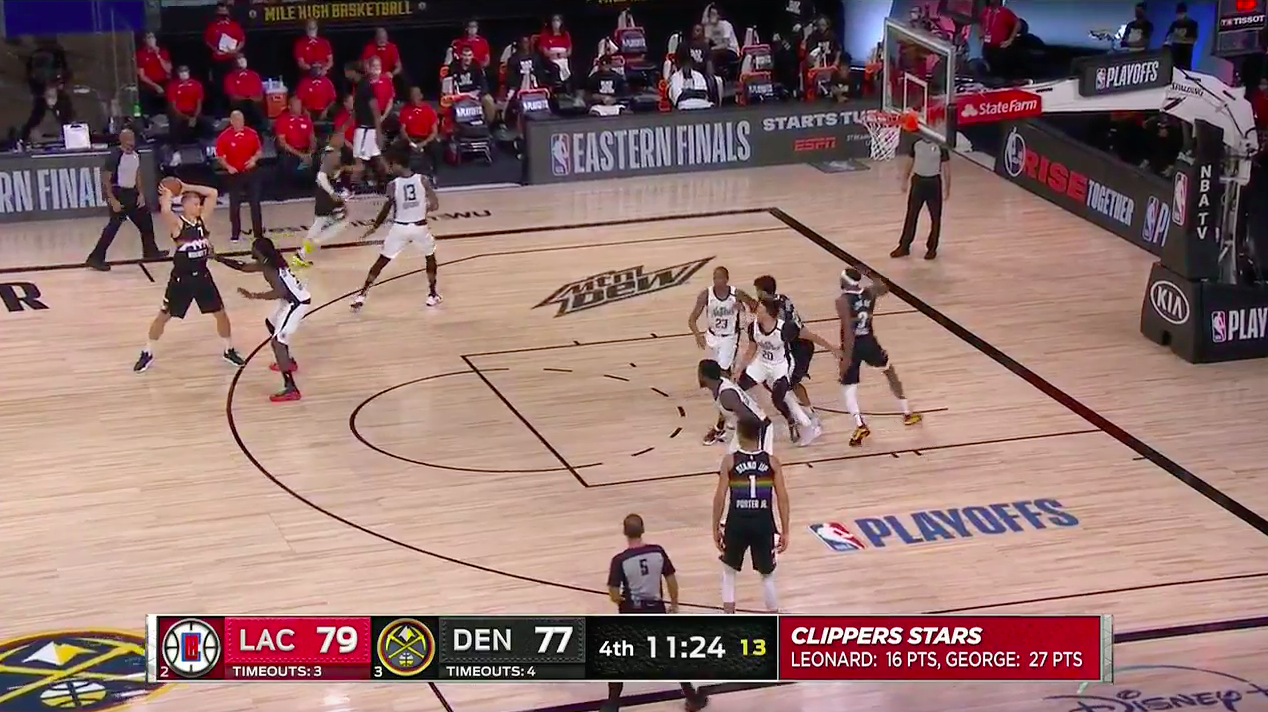
In the post, he’ll often dribble out to a teammate to hand the ball off as he becomes a screener (then roller), which I think is a neat way to create offense for others.
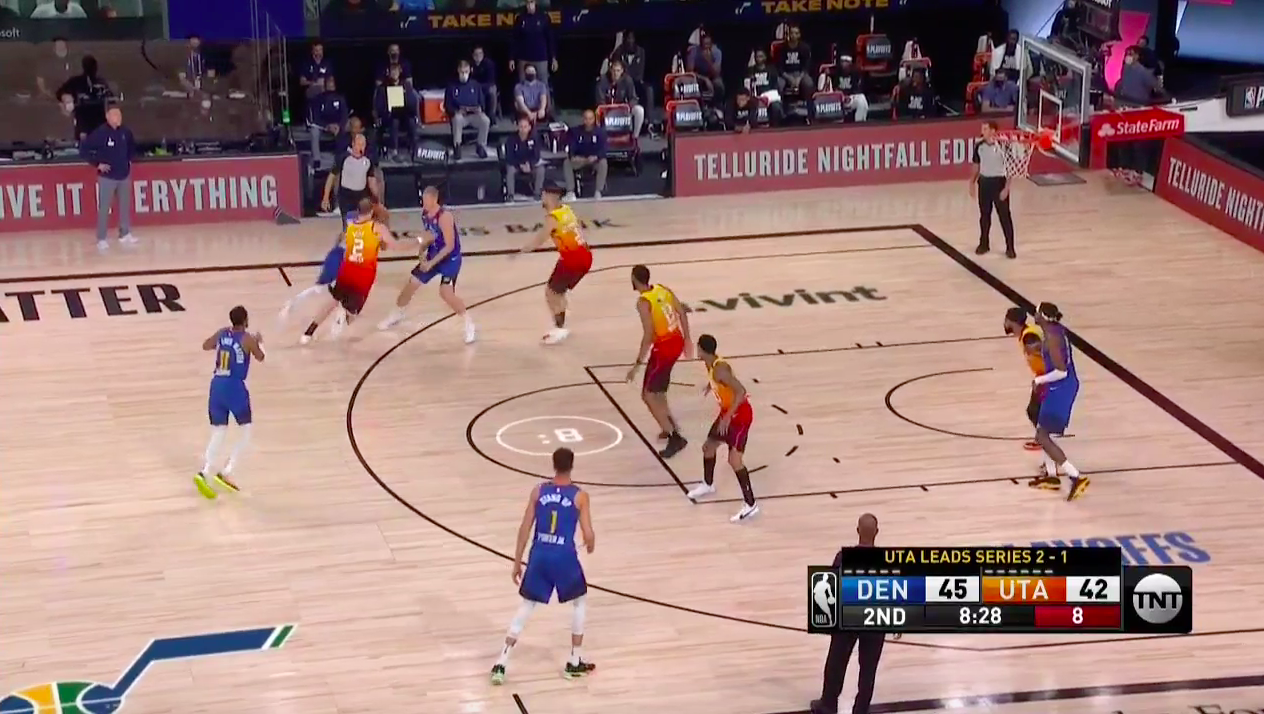
He also knows that post touches often collapse the defense, so he’s often looking to catch the ball in deep post position to then pass it right back out for an open shot.
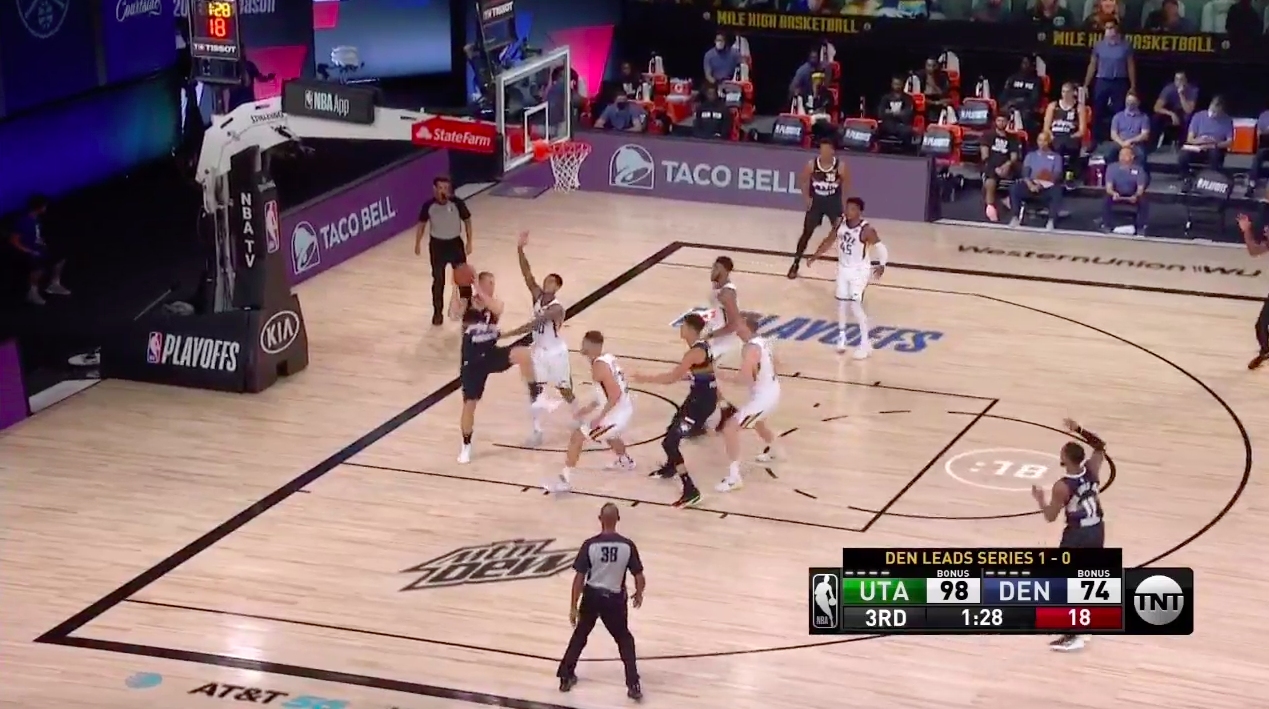
While Plumlee is an excellent passer for a big, I counted only 1 assist in 22 bubble games for Plumlee. He’s not a concern of mine (until proven otherwise) passing out of the short roll. Rolling to score, he’s strong when he has an unimpeded path to the rim, but isn’t too good a scorer if he needs to score around or through someone. But Because of that, I’m more willing to hard hedge or double team Murray ball screens with Plumlee.
Sticking with Plumlee for a moment, he’s a very similar as a passer to what Nurkic brings to Portland. Handoff assists, excellent simple passes, great passing when given time and space to make passes to cutters in sets. While him not being much of a shooter may make sagging off him on-ball appealing, get in his face and that playmaking drops precipitously.
Jokic, however, is an elite short roll passer and a good scorer. The only player this season with a more efficient floater on 1+ attempts per game was Brandon Clarke. Because Jokic is less of a lob threat, LA has more time to recover to passes to him rolling. And he isn’t quite an elite roll scorer, but he’ll finish the good looks and has enough ball handling ability to make moves to get around/past a recovering defender to create more good scoring opportunities.
Denver often runs pick and rolls with two offensive players standing close to one another. I’d take that invitation to send extra help to the paint and zone up those two players, if weak side, and just be aware of and communicate about potential cutting. LA has ballhawks to play the passing lanes and zone up effectively while making Murray’s reads more difficult.
If you hard hedge the Murray/Jokic ball screen, Denver will in future possessions run pick & rolls towards the side of the court with two offensive players and little room to drive, with no intention of Murray looking to score, specifically to get Jokic open space to roll and make plays.
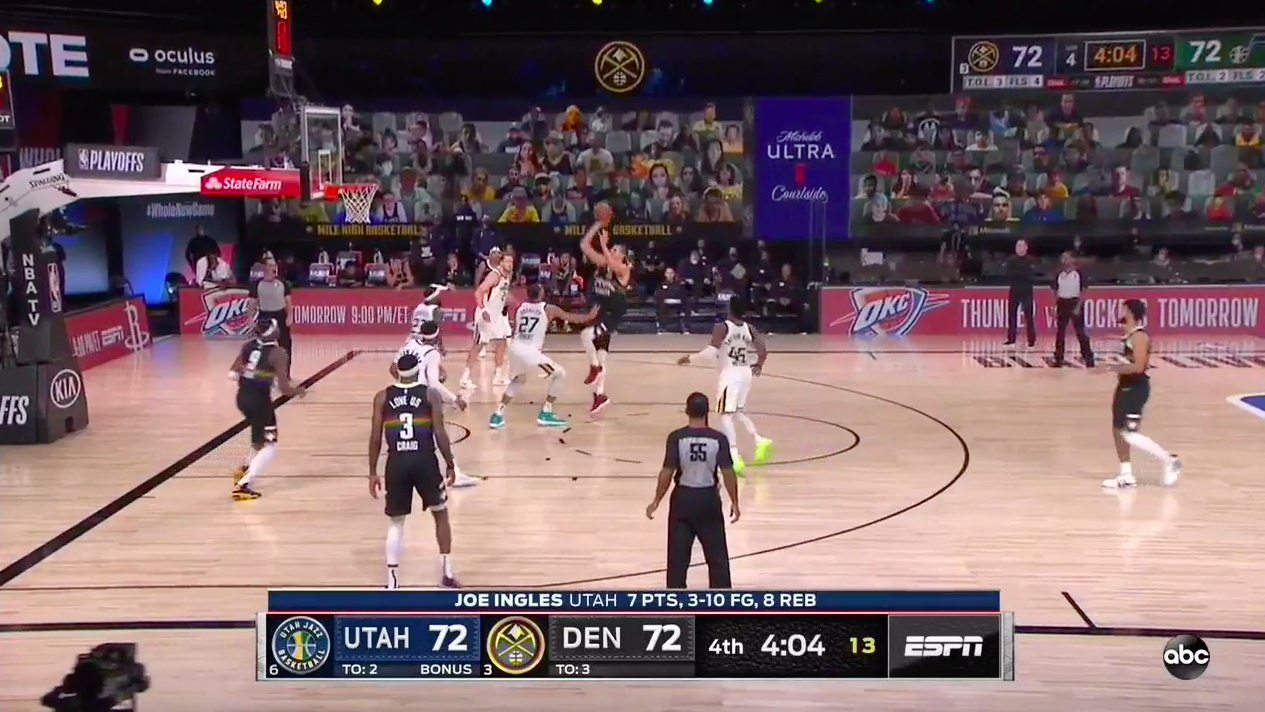
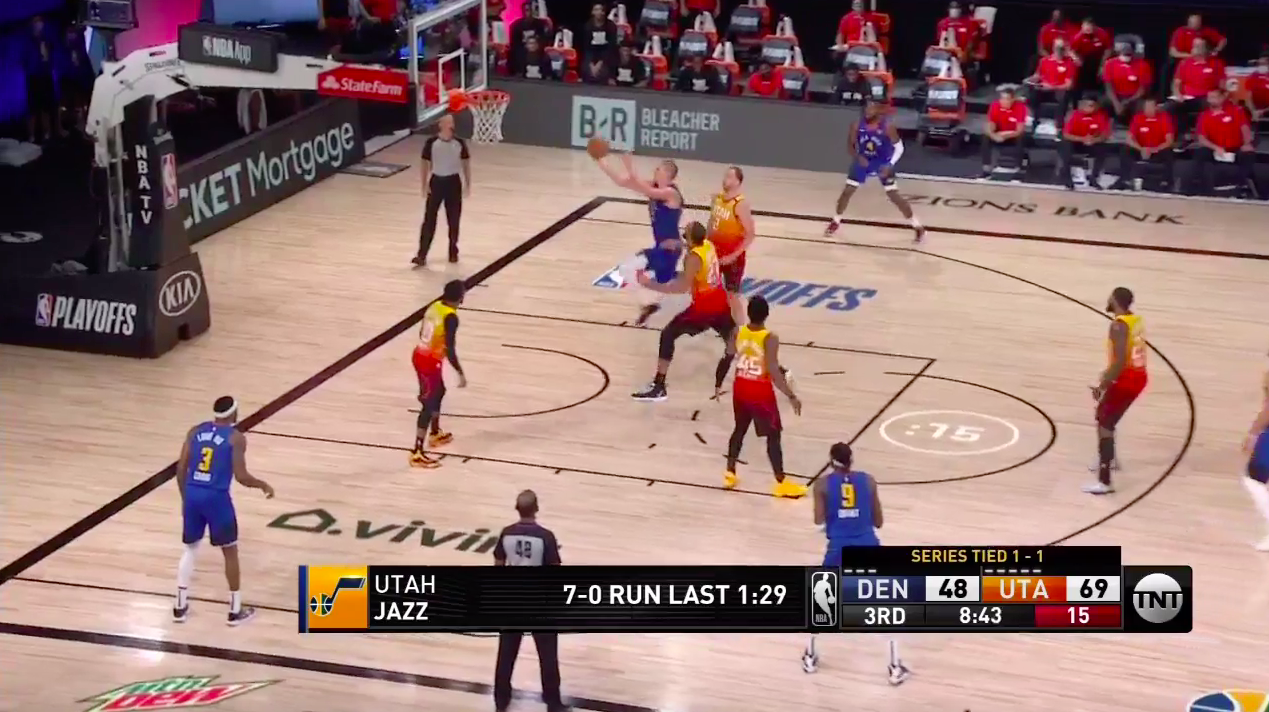
Jokic will score and make plays for teammates on high volume if you give him those looks. I’d rather not.
Drop Coverage
One coverage that fits what LA has done during the regular season but wouldn’t be my go-to against Denver is drop coverage. Jamal Murray likely won’t be shooting as insanely well as he has on pull ups, but that gamble is less appealing when considering the rest of the implications of this coverage.
Murray being a crafty ball handler in these situations has led to many situations where Murray penetrates towards the rim just a bit, dragging both defenders with him, just to kick out to a more wide open Jokic than you’d otherwise see with a quicker kickout.
Drop coverage won’t give up nearly the same volume of playmaking opportunities to Jokic, nor will you be looking at any roll/slip opportunities, but open 3s for Jokic and pull up 3s for Murray isn’t my idea of the best option.
The Plan: Switch (usually)
My game 1 game plan would be to switch the Murray/Jokic pick and roll. And after watching some more film on LAC-DEN, I’d mix in some doubles or hard hedges as well while bringing help to try to take away the pass to Jokic in the short roll while making Murray need to skip pass to the opposite corner. And I’d look to hard hedge, “weak,” or double when Plumlee or Millsap are involved instead of Jokic.
For some background, LA has shown a few coverages at Murray on the year. They had success switching and hard hedging at times and gave up a lot of open pick & pop 3s when playing drop coverage. But him needing to make plays over LA’s length and athleticism compared to getting shots he likes and Jokic being handed open pick & pop 3s or playmaking opportunities sounds favorable to me.
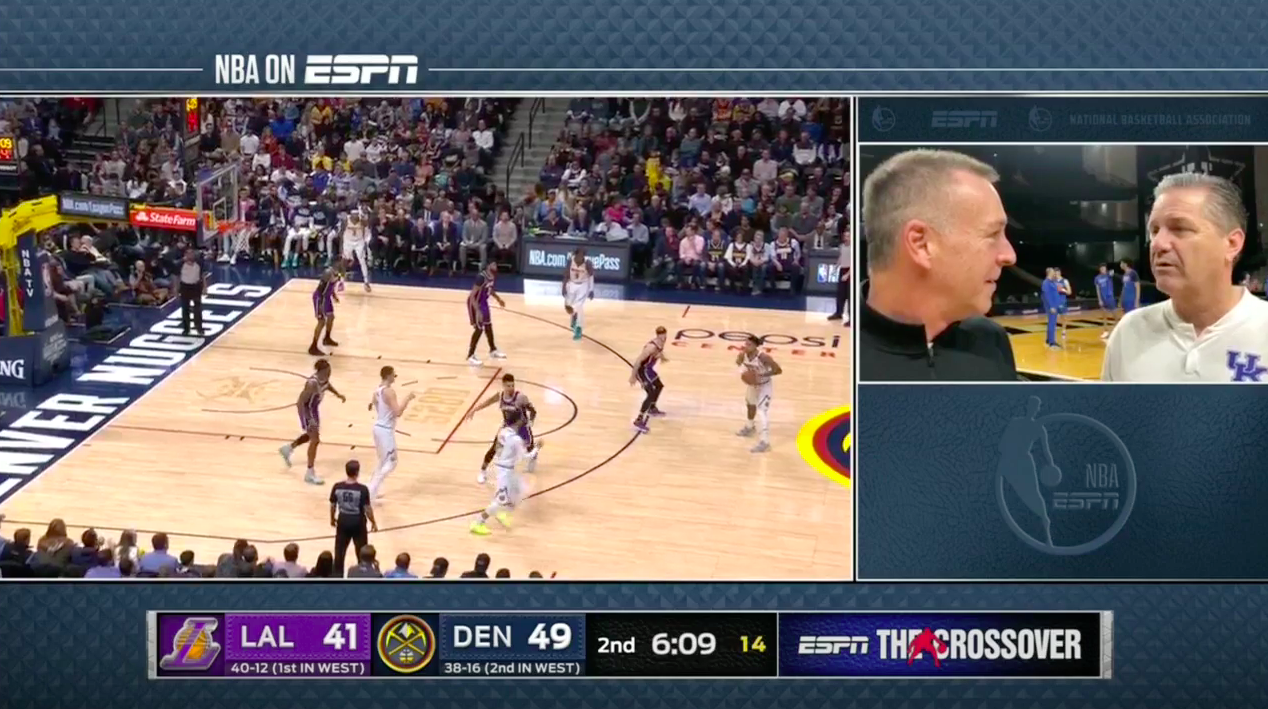
Is this a perfect option? No. Denver having both a guard that can isolate and a big that can attack in the post means this option won’t shut down their scoring the way LA did with Dame or Harden with how they defended them at times. But LA presents Denver with personnel unlike what they’ve faced so far during the playoffs. Switching on the season hasn’t fared all that well against Murray/Jokic, but the Lakers are better equiped to do so than Utah, the Clippers, and most other teams.
This potent pick and roll attack, which is the engine (along with Jokic post ups) that powers the offense for many other Nuggets players, will face its greatest challenge so far in these playoffs.
What this concedes is isolation for both Murray and Jokic, which I’m fine with. If those two players, coming off of consecutive 7-game series, can shoot and make high volumes of attempts against good defenders for 48 minutes a game, you tip your hat. But with how strong the Laker offense looks like it’ll be in this matchup, I like my odds in that scenario.
But let’s dig into that portion of their game, since Jokic post ups and Murray isolation are also among Denver’s top scoring approaches.
Nikola Jokic Post Ups (& Isolation)
The pick and roll for Denver is undoubtedly a driver of offense for the team, both directly for Murray, for Jokic as a roll and pop man, as well as for the other Nugget players from passes from the two of them.
But guess how many made shots Denver has from Jokic isolation pass outs during his 14 postseason games. One. Three for Murray. If you force them to isolate, that pipeline to the rest of their team takes a big hit.
And when Jokic hasn’t passed out from perimeter isolation, he’s scored 0.88 points per possession as a scorer this postseason. That’s worse than during the regular season, where that value was 0.99. But either value isn’t an efficient enough offense to scare me as a Laker fan, particularly with LA’s defensive personnel.
Jokic will likely turn many of these mismatches into post ups instead of isolating far from the basket, but that provides LA with time and opportunities to disrupt between him getting the ball and looking to isolate. I wouldn’t rule out temporary double teams to get a guard out of a mismatch, but in general, if someone like LeBron/Morris/AD/McGee/Howard is on him I wouldn’t be doubling.
Speaking of doubling, Denver has a fairly simple adjustment that’s quite similar to the cutting approach I outlined to how Houston could’ve adjusted to LA’s double teams last series. On the side of the court that has the 3 on 2, the Nuggets send a cutter and space their other two shooters so create the furthest stretch of the 2 defenders as possible.
Here’s what that looks like, and it’s their go-to. They ran it like 14 times in a row against the Clippers and continuously got good looks (which I find hilarious).
Watch this possession. Simple Xs and Os, but an effective counter to a post double creating a 3 on 2 weak side.
You can even see Craig waive the cut through. Cut + spacing between the 2 shooters will = open passes and easy shots.
This is Denver's go-to vs a post double. pic.twitter.com/3BrbY6PGOA
— Cranjis McBasketball (@Tim_NBA) September 17, 2020
LA would have some chance doubling against a less competent staff, but doubling against Denver won’t work unless you have several large players to blanket Jokic. Their counter takes a couple seconds to develop, which is why I’d be open to a quick double to take a bigger defender to Jokic and bump his mismatch back toward the rest of that trio of offensive players.
When it comes to Jokic attacking in non-mismatch situations, LA will present a tough challenge for the big Serbian. Dwight Howard and Anthony Davis are excellent post defenders. JaVale McGee is far worse, so I can see that factor impacting his playing time this series (although he’s a better perimeter defender than Howard).
LeBron and Markieff Morris have also been effective post defenders this season, albeit on smaller volume. I don’t see them as pushovers for Jokic, but they should still present favorable matchups.
If LA did want to bring help, having Jokic’s primary defender sit middle and bringing help baseline might be effective. Jokic is more efficient, draws more fouls, and more frequently attacks middle than baseline. Pushing him to where he’s less comfortable and having someone sitting in his blind spot to take a charge or wall up might be effective.
Bringing a second defender while he’s facing up would be dumb, due to his vision and ability to get passes off even under pressure. And when he does face up, get into his body and make that jumper he likes to take uncomfortable. Jokic has been quite effective taking those, but far less effective when needing to drive after facing up.
Bringing help also opens the Laker defense up even more to pass outs from Jokic to teammates. On the year, the top 3 players in post pass outs leading to offense from teammates are 1) Jokic, 2) LeBron, and 3) Anthony Davis. Even when you don’t double, Denver will look to generate offense for others through cutting and screening around Jokic as he operates. And that cutting and screening occupies would-be help defense, making Jokic’s life easier as a post scorer.
Denver knows defenses will often ball-watch, so they send cuts to the middle, under the rim, use split cutting action to possible get flares open and slip screeners in those actions to get more cutting at the rim, and are the most purposeful team I’ve seen around keeping good spacing among shooters weak side.
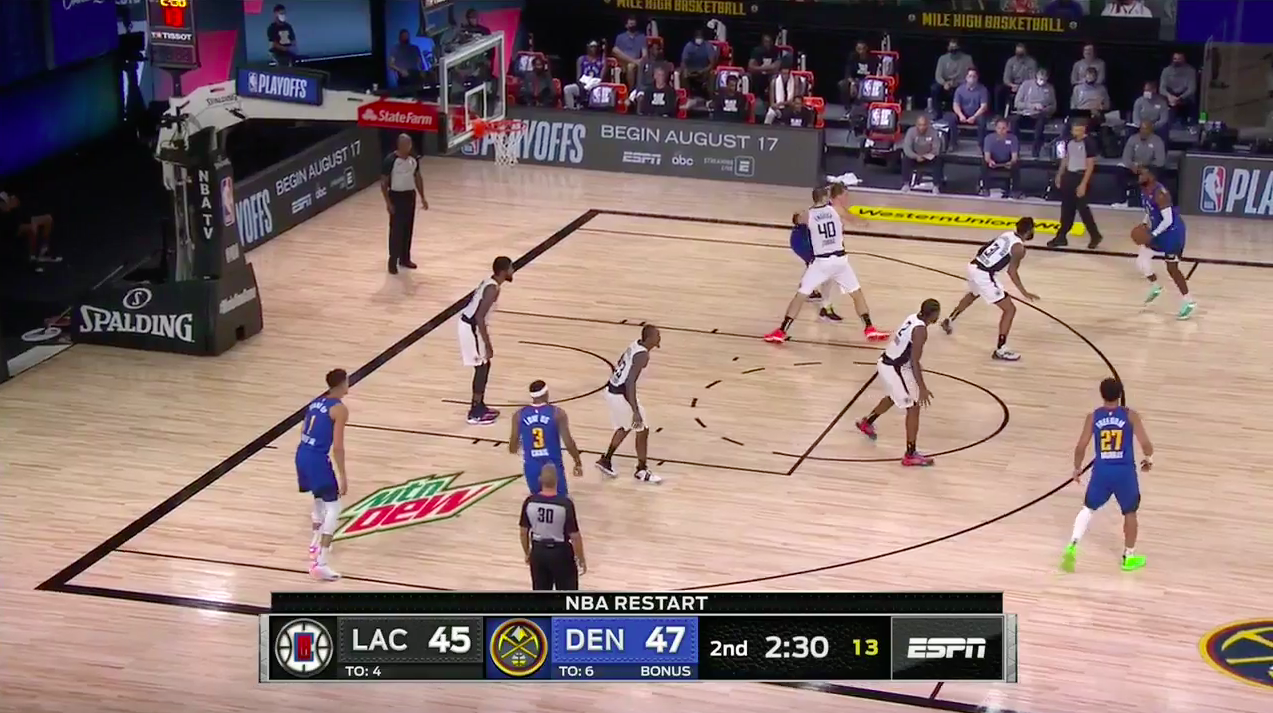
Staying awake weak side to not get “face cut,” where the cutter can run free right past you, will be key. Getting in the way of those passes, bumping cutters, and making Jokic need to be the sole form of offense when he posts up will favor the Lakers. And as I cover a bit later, I’d rather go under flare screens and contest shots that way than switch and concede cuts to the rim.
Jokic also has a tendency to act/flop a bit in the post, which may get Dwight in some foul trouble (which he already does often himself):
Things might get a little floppy in the post this series.
Look at Morris just keeping his hands up and watch Jokic latch on and whip himself backwards 😂😂 pic.twitter.com/oI5TheAYeQ
— Cranjis McBasketball (@Tim_NBA) September 17, 2020
I also see value in “three quartering” from the high side and getting behind on the throw, to attempt to deter passes to Jokic by presenting a difficult post entry to the ball handler’s looking to feed the Joker.
In general, LA should fare well defending the post when not in mismatch situations, so I’d want the other Laker defenders tuned into their man and not giving up open buckets from ball watching and getting face cut by their assignment.
I’ll have more suggestions based on how game 1 goes in terms of the matchups Jokic is getting, the types of looks he’s getting post ups from, and how well he’s getting to his shots (or not).
Jamal Murray Isolation
As mentioned before, Murray isolations have been a creator of offense for him, but not for teammates. That has value.
A philosophy I’ll bring into this series is one of making Jamal Murray need to beat LA with his passing, not Nikola Jokic. That doesn’t mean give up 4 on 3 scenarios, but I’d prefer to have Murray, who has an F Passing Efficiency and a D+ Passing Versatility, need to be the one making tough post entries, skip passes, lobs, etc. That can mean finding ways to bring extra help on him or for his cutting teammates, and daring him to make tougher passes.
Compare him to other Guards with 500+ minutes played this season and Murray’s Playmaking data looks even worse:
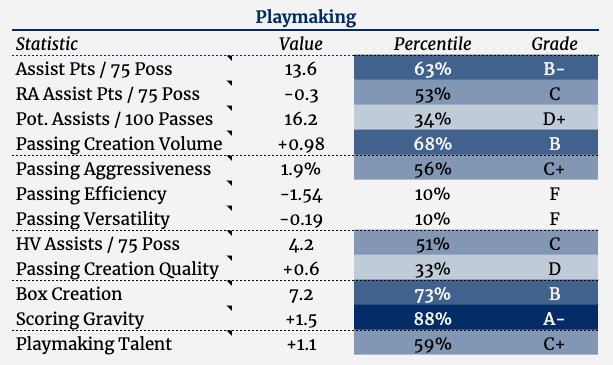
I see an opportunity here for LA to exploit someone who isn’t a true playmaker.
I’m also going to bank on him not continuing to score almost 1.5 points per possession (which is a crazy high number) and fall back down to earth in a larger sample and against good defenders towards his 1.0 points per possession mark on the full season. That’s good for isolation, but a 100 offensive rating won’t cut it against the firepower LA has on the other end of the court.
In the more “feel good” than predictive category, Murray has scored only 11 points on 18 possessions against the Lakers this season. The series will be over quickly if Murray scores 0.61 points per possession. I feel confident in Alex Caruso, AD, LeBron, and even Danny Green and Kuzma a bit to defend well in these situations.
Here’s Murray’s shot chart isolating this season. Not too efficient scoring when it comes to the top of the key or at the rim.
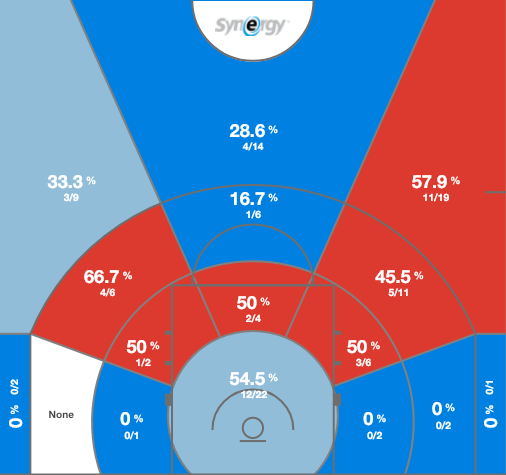
Murray not getting to the rim with any consistency is part of why his isolations generally don’t create offense for others.
Jamal Murray Handoffs
Murray is tied for first (with Bradley Beal) in terms of most handoff scoring possessions per game on the season. On the full season, his efficiency has been good. In the playoffs, much like his other areas of offense, he’s been on fire.
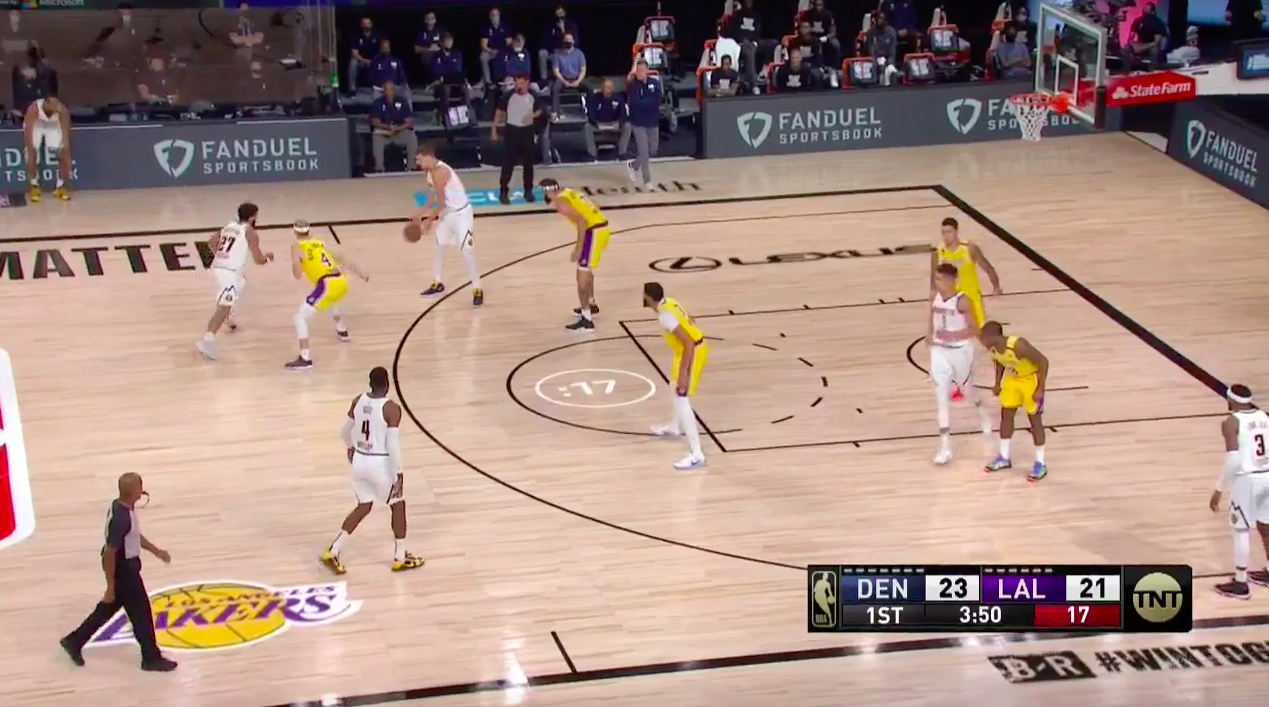
These work for Murray as pick & roll type looks, but put him in a position where he’s able to explode to penetrate toward the rim or shoot with his feet set after getting the ball flipped to him, depending on how the defense plays it.
Go under and you’re opting to give up that 3-point attempt. Follow him and you let him turn the corner unless you hedge hard, which rarely happens due to that requiring the big to step away from Jokic, which gives up a driving lane to Jokic if he were to keep the ball instead of hand it off. And an attempt at a hard hedge also gives up the Jokic roll.
I’d go over but play for the pass to Jokic with my guard, and have the big take over in a switch. This’ll take away the 3-point look, get him funneled into mid range toward a shot blocker, and attempt to take away Jokic as a facilitator.
Monte Morris Pick & Roll
The Monte Morris pick and roll is less worrisome than ones run by Murray, but if Jokic is involved you still need to worry about his playmaking or pick and pop looks. But in general, this isn’t the type of offense I’m too worried about from Denver.
If Jokic is involved, I’m fine switching these. If he’s not involved, drop coverage, LA’s “weak” coverage, or hard hedges all work. I’d expect “weak” but drops wouldn’t surprise me.
Denver’s Top Sets
I’ll add more to this section as I get some more film work done and plays diagrammed, but I’ll start by noting that Denver uses a lot of off-ball motion with cutting and screening to create scoring opportunities.
Jokic and Plumlee as passers from the perimeter lets Denver use the skills of those players to find good looks while providing the bonus of removing rim protection from the defense. I’d want ball pressure on those players to make those reads harder.
When it comes to back screens or other attacks going towards the rim, I’m fine switching.
For off-ball screens for flares or pin downs, I’d go under and dare players to have the IQ (along with the passer) to read that coverage and fade to the open spot. Denver doesn’t do it often, and they scare me far more from cutting against switches in these situations than they do from those actions themselves. Trailing may open up drives to the rim, so going under off-ball screens is in general how I’d start this series.
Matchups
This series has several interesting points. One of which is how the Lakers choose to match up against Denver, particularly late in games.
A big boost for LA is LeBron being able to defend Millsap, Grant, or whoever Denver might have as a PF alongside Jokic. That lets you take AD and put him on Murray, which is a matchup I’d be looking to use fairly often.
Alex Caruso will make for another good Murray matchup, and I expect to see Rajon Rondo get some time on him as well.
Jokic will draw heavy doses of Dwight Howard and Anthony Davis this series in my eyes. It’d be huge if Markieff Morris or LeBron can hold their own against him. JaVale McGee will be on him frequently as well, if he plays. But I can see a scenario where LA plays Howard more and McGee less based on Howard’s large edge with his post defense.
Putting Dwight on Jokic and AD on Murray takes away their pick and roll and Jokic’s isolation game, whether on the perimeter or in the post. What it’d leave is Murray vs Howard on the perimeter, which I can live with if it’s not generating offense for the rest of the team and LA is able to do their thing on offense. I’d look to go to those matchups often.
LA has a lot of room to mix and match other matchups in this series outside of those two players, since the rest of this team isn’t going to run pick & roll, isolate, or post up against you with much success or volume. Being aware of potential cuts and defending actions within sets is what I’d focus more on outside of these two key players.
Zone
I don’t expect much zone from the Lakers this series. Or at least much success in zone. If LA is going to zone, I’d guess it’s more out of desperation than a proactive, aggressive move.
Related to that is how Denver may not be the best team to zone up against. The Nuggets have had the most efficient offense this season against zone defenses. They’re well coached, run good sets, and have the personnel to get Jokic inside the zone and break it down with screening and cutting.
The Lakers Offense
While I see LA as able to defend Denver well, I really like this matchup from a Laker standpoint.
Rim Protection
Let’s start with a big weakness for Denver: their rim protection. In terms of the defensive roles we use at BBall Index, Nikola Jokic is the only Denver player that ends up being categorized as an Anchor Big, meaning he’s often put into the job of big man defending the rim.
The issue is that he’s not too good at that. Here’s his Interior Defensive data from his Player Profile, which you can access with our Data & Tools package, compared to other Anchor Bigs:
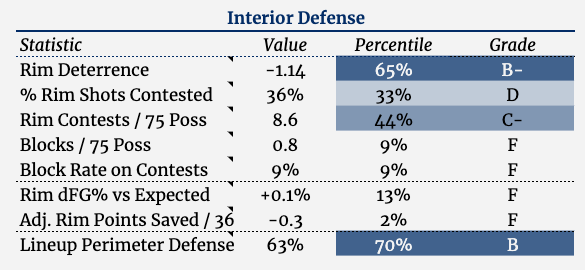
Here’s how to read this:
- Jokic’s B- Rim Deterrence means his presence on the court has led to fewer attempts at the rim. That’s good.
- His D percentage of shots at the rim contested and C- rim contests per 75 defensive possessions on the court aren’t strong.
- When he is challenged, he hasn’t performed well. From a lock standpoint, he’s not getting many (F) and not getting many when he is contesting shots (F).
- Opponents are scoring higher at the rim when he’s their defender than they’d be expected to score. We see that for Rajon Rondo’s defense, but it’s quite abnormal for a big to have data like this. And when you look at how often Jokic defends the rim along with that performance against him, his “points saved’ is actually negative. Not good.
- The perimeter defense of the players around Jokic fares well for him, being higher than 70% of other Anchor Bigs.
And this is an area that Denver has somewhat gotten away with, at least compared to what they’ll see LA do. The Clippers and Jazz as teams have above average Finishing talent grade ratings, which looks at their ability to get to and finish at the rim. The Lakers have an elite rating as a team.
If you stack up all players from Utah and both LA teams, the Lakers have 3 of the top 5 players in our Finishing talent grade.
Last round in particular, LAC didn’t have strong guys getting to & finishing at the rim. Their only guys with B or better grades in our Getting to Rim and Finishing at Rim Ratings are Kawhi, Reggie Jackson (who became unplayable due to his defense), and Montrezl Harrell (who was also a huge liability on defense).
Denver will face a different stress vs LA than they have in the past.
Post Ups
Now let’s get to what won’t be fun. Post ups.
LA has scored less than 0.8 points per possession on post ups against Denver for a reason this season. I went through and watched all of those possessions, and almost every single time I saw Denver bring extra help. And they do so more aggressively than Portland or Houston. Those teams were looking to deter, by being in the way. Denver is looking to disrupt, through actually getting a double team on the ball. This isn’t what they do all the time, but it’s what they’ve used against the Lakers and what I’m anticipating seeing against LeBron and AD as they face otherwise juicy matchups against mediocre to poor post defenders.
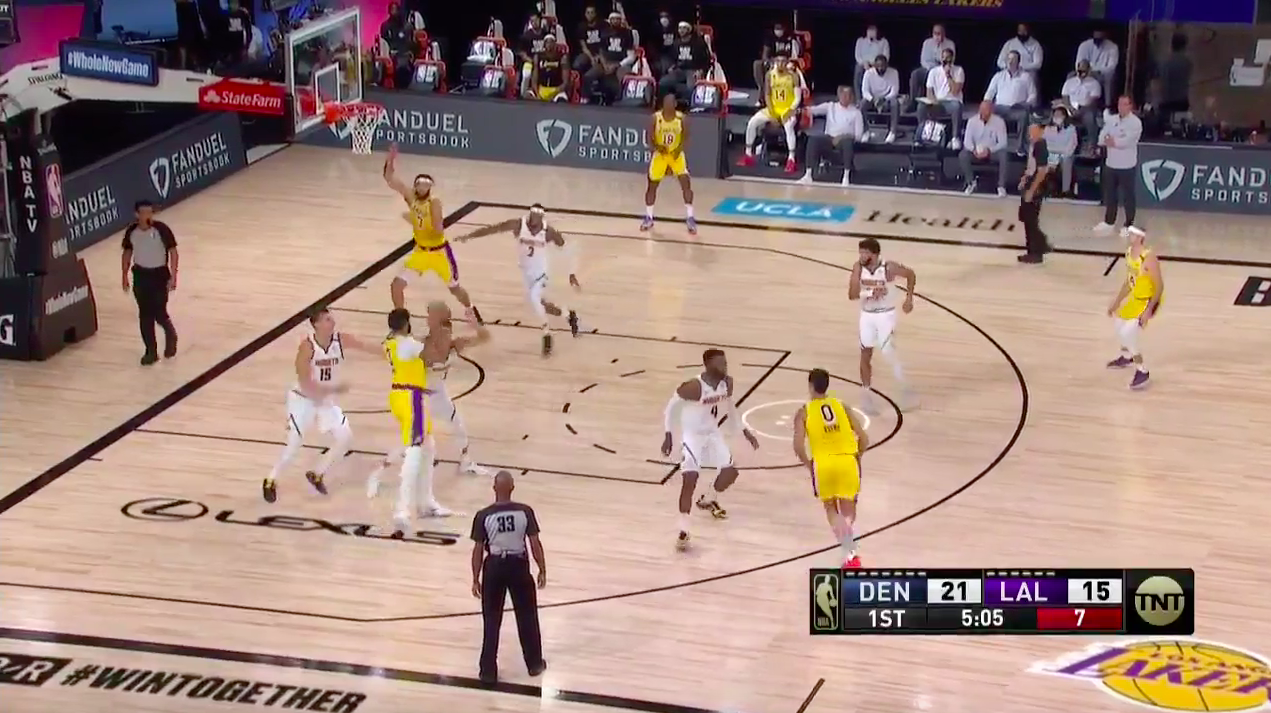
What makes it trickier is how they’ll vary where it’ll come from. Sometimes from the top, sometimes baseline. Sometimes they’ll try to bait you into throws, with a defender standing in front of one offensive player and waiting to sprint in the passing lane for another. AD and LeBron will be bothered quite a bit and run into tough situations if they’re backing down a defender.
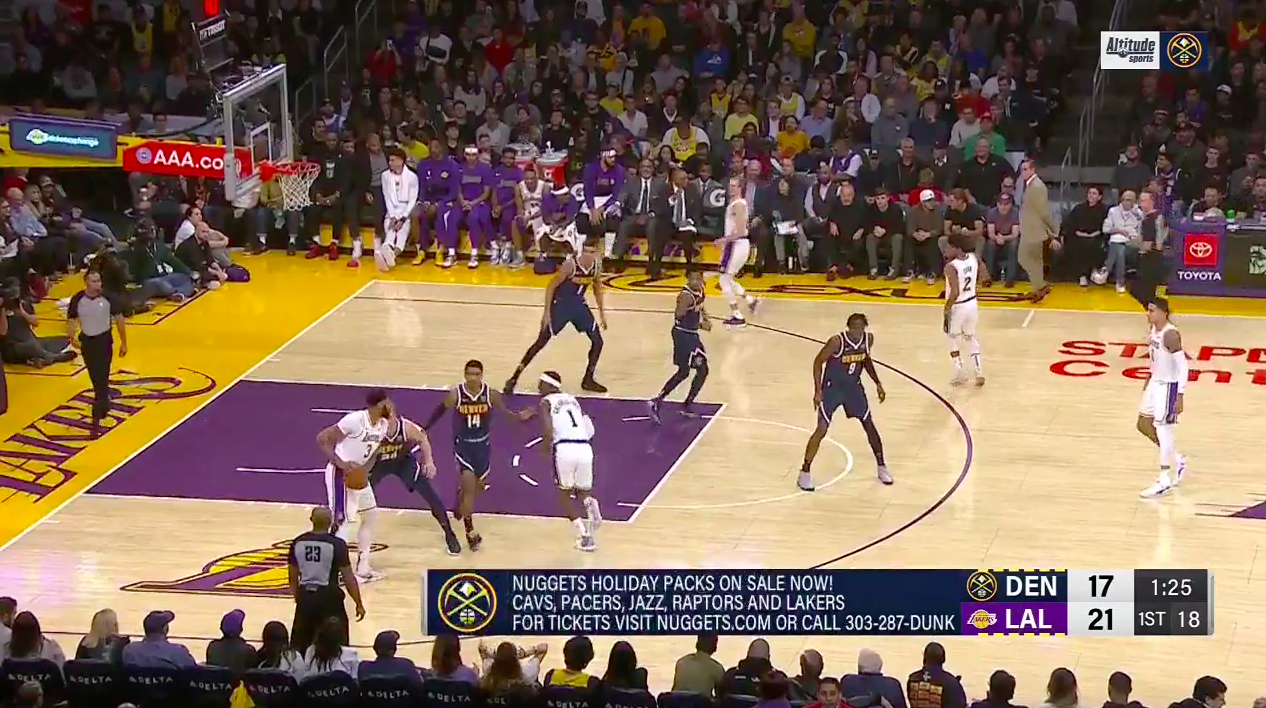
LA can do a few things about this:
- Facing up helps the offensive player survey the situation far better and avoid blindly turning into a help defender. This is very doable for LA.
- Playing small ball and having all other players space the floor, and do so without just standing next to each other, makes the passes easier to make. But Denver will send help even if you go 4-out 1-in, so be prepared even in small ball lineups to see extra help.
- Using lob threats to keep help from coming, but we saw against Houston and their short defenders that LA won’t throw to those. So that option is likely out.
- Not posting up on an empty side. If you give the defense a 4 on 3 weak side passing out of a double you’re not going to find open shooters. A 3 on 2 situation makes that slightly easier, and the defense is less likely to help off a shooter right in front of the post player.
- Using simple cutting in those 3v2 situation. You can cut one of those players and have shooters at the lane line extended and corner. Ironically, that’s literally what Denver does in these situations. But LA doesn’t do much of this, so I’m not sure how high to set my hopes.
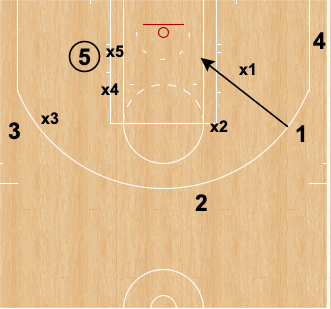
Targeting Weak Links
One area of the Clippers’ offensive approach that I found frustrating last round was how little they attempted to attack poor Denver defenders.
Based on the film I’ve seen this year and some components of our Perimeter Defense talent grade 2.0 (my attention has been taken away from finishing that for these breakdowns), here are some of the weak perimeter defenders LA can look to target:
- Mason Plumlee
- Paul Millsap
- Michael Porter Jr., who literally has teammates needing to point constantly to tell him where he should be standing defensively
- Jamal Murray
- Torrey Craig
- Jokic has actually done well due to his length, and I’d want to attack him in slightly other ways
That’s a lot of guys.
Using butt screens, where the screen comes behind the defender and effectively takes him out of the play, would be one way to get some switches early in a possession. The same can be said for step up screens on the sideline, back screens, or several of the other tactics I covered that Houston uses in last round’s breakdown.
LeBron should be hunting the matchups he feels benefit him most, then attacking. Going after Jamal Murray in particular would be a smart way to potentially have the bonus of getting him in foul trouble and tiring out a player with a massive load on their plate this series, coming off of games every other day for 7 games each of the last two series.
Ball Screens
A piece of the Lakers’ game this postseason that has been used less than in the regular season has been their pick and roll attack. This is due to opposing teams clogging the paint and/or switching ball screens to attempt to negate the action, combined with LeBron’s unwillingness to throw lobs to roll/slip men.
Denver is one of the league’s most aggressive ball screen defenses, with elite rates of blitzing and hard hedging along with a good bit of switching. They don’t run drop coverage much.
Denver has hard hedged often against LA this season, which has limited LA’s ability to penetrate with their ball handlers and has pressured those ball handlers, resulting in a number of LeBron turnovers. But what it does give up are slips, which hopefully we see an improved willingness to utilize this series. LA did well to attack the coverage they were shown in their bubble matchup, so I feel pretty good that they’ll do it again.
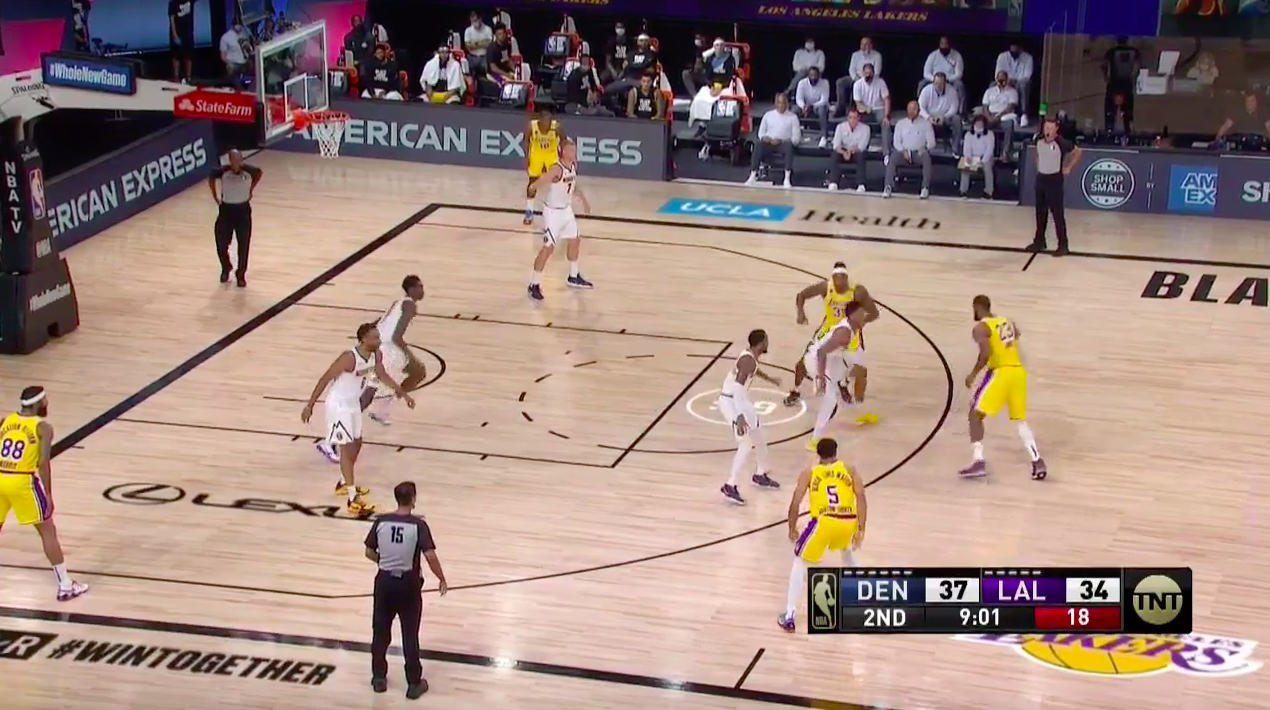
This slipping also collapses Denver’s defense, which will open up catch and shoot 3-point looks and also provide opportunities to attack closeouts. In that way, I think this is a series that can be really good for Kyle Kuzma.
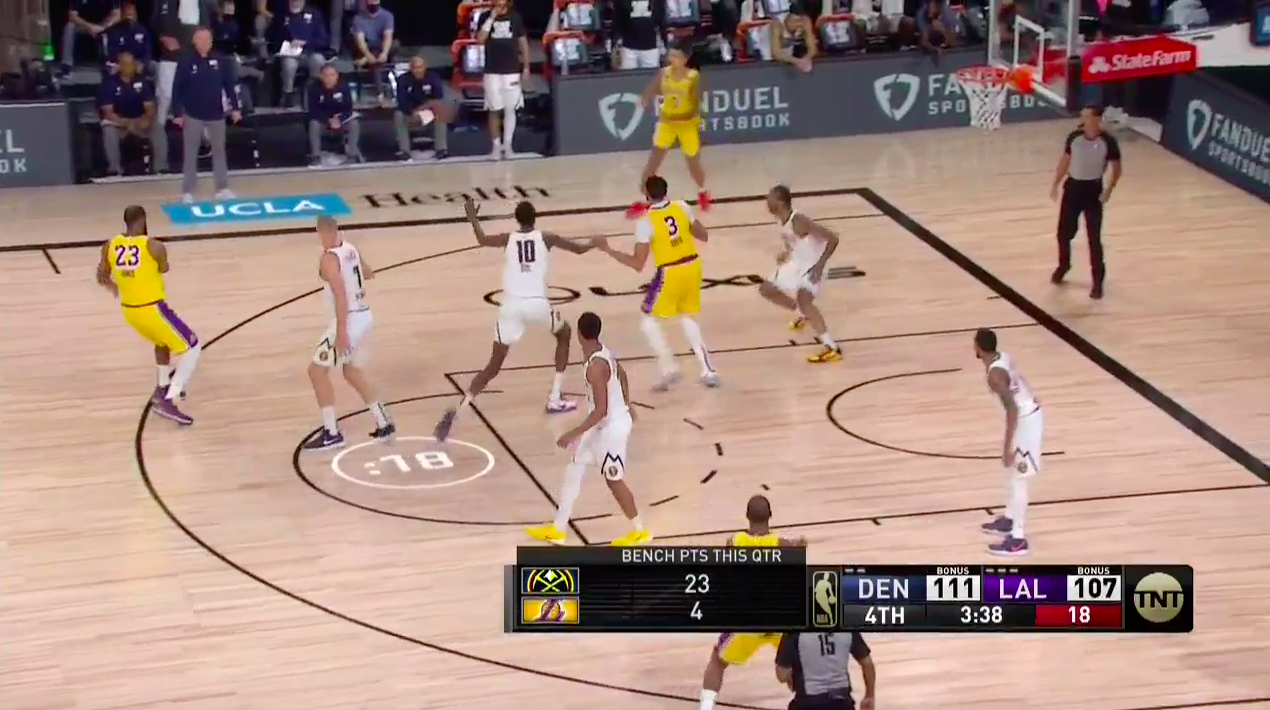
This defensive approach also concedes pick and pops, which AD and Kuzma should look to attack.
Another form of a pick and pop is a ghost screen, which is like if a pop were combined with a slip. LA uses this for their inverted pick and rolls often, when a guard sets a ball screen for LeBron. LA can do that, and can also use these with Kyle Kuzma, due to his 3-point shooting and fluidity.
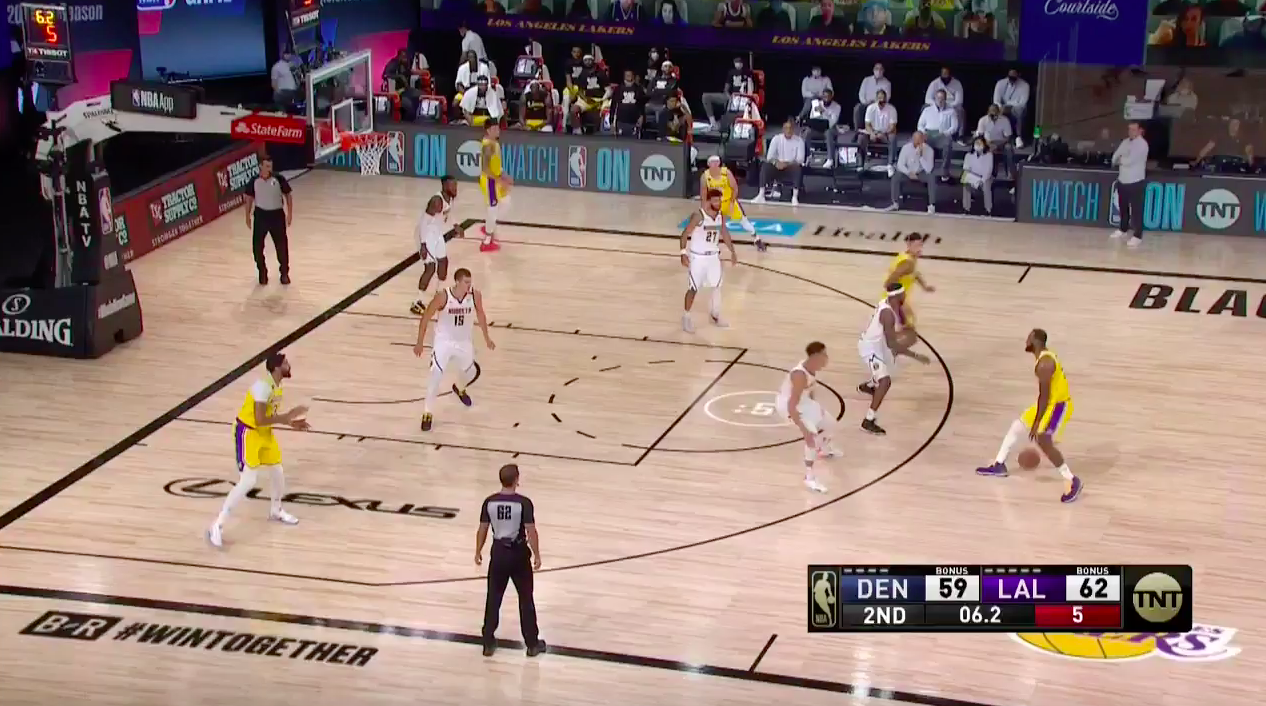
I expect LA’s pick and roll attack to be revitalized this series and see high volume. Especially in small ball lineups, getting the big man involved in the action and forcing smaller players to need to defend the rim makes AD’s life much easier rolling.
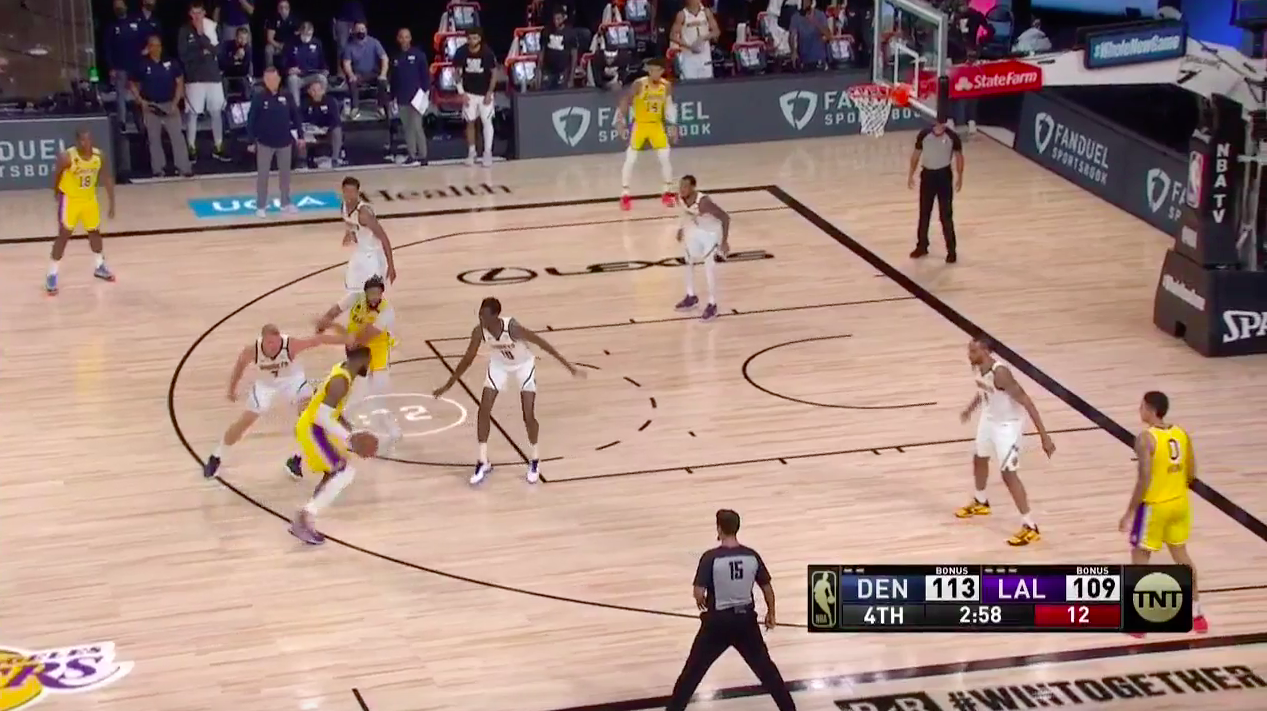
Denver also has a number of poor pick and roll defenders that LA can look to attack. Anytime you get Plumlee/Grant/Millsap/Jokic/Porter being screened, they’ll likely be wiped out of the play. And attacking Jokic or Porter as the big man defender in the action will be most beneficial for LA. Keep an eye out for LA to target those matchups.
Zone
Denver used a 2-3 zone against LA in their regular season bubble matchup. On the year as a whole, they’ve barely used any zone. Less than 50 total possessions.
Might we see it? Sure. But that zone may have also been a function of some of the funky lineups Denver threw out (full of bigs).
If they use any in game 1 we’ll break down how the Lakers can attack it. One quick note would be that using lob threats and attacking high-low while attacking with LeBron in the high post and shooters around the perimeter is a good start.
Matchups
I’m anticipating seeing Gary Harris start on LeBron, with Craig being a backup LeBron defender. Those are Denver’s only two players who have gotten the “Wing Stopper” designation in the defensive roles we use. And Harris is very strong defensively, but Craig should be someone LeBron can go after a bit more on-ball. Grant is another player that Denver used often against LeBron this season.
The NBA’s tracking data has LeBron shooting 4/15 against Craig this season and 1/1 against Harris.
We’ll see a lot of Millsap and Jokic defending AD, with some Plumlee and possibly Grant as well. The NBA’s tracking data has AD shooting 12/18 against Millsap this season and 9/22 against Jokic.
If Denver won’t concede switches, and sticks to their hard hedging and blitzing, LA will hurt them with rolls and pops. If they do switch, I’d bet we see a lot of different matchups for each of these two star Laker players.
Playing Big vs Small
One aspect of this series worth exploring is how the Lakers can choose to play either big, small, or even smaller, with lineups having McGee/Howard at center, AD at center, or LeBron/Morris at center.
Making this more interesting is that Jokic will play, whether LA plays big or small. So the Lakers playing small will impact Denver’s lineups less than it might have against other teams.
When looking at this season, and filtering out garbage time minutes, here’s how the Laker offense looked against Denver when going big vs going small:
| Los Angeles Offense | ||||||
| Small | Big | Going Small | ||||
| PPP | Freq | PPP | Freq | PPP Diff | Freq Diff | |
| Spot Up | 1.15 | 14.3% | 1.15 | 23.2% | 0.00 | -8.9% |
| Transition | 1.15 | 18.0% | 1.23 | 15.0% | -0.08 | 3.0% |
| P&R BH | 1.00 | 6.9% | 0.93 | 13.0% | 0.07 | -6.2% |
| Iso | 0.56 | 8.5% | 0.94 | 7.7% | -0.38 | 0.7% |
| Putbacks | 1.11 | 9.5% | 1.43 | 6.8% | -0.32 | 2.8% |
| Cut | 1.50 | 7.4% | 1.00 | 8.2% | 0.50 | -0.8% |
| P&R RM | 1.05 | 10.6% | 0.55 | 5.3% | 0.50 | 5.3% |
| Misc | 0.89 | 10.1% | 0.43 | 3.4% | 0.47 | 6.7% |
| Post-Ups | 1.00 | 3.7% | 0.78 | 8.7% | 0.22 | -5.0% |
| Off Screen | 0.54 | 6.9% | 1.00 | 5.3% | -0.46 | 1.6% |
| Handoff | 0.75 | 4.2% | 0.29 | 3.4% | 0.46 | 0.9% |
Overall, the Laker offense was about as efficient in both situations. We saw the team get more scoring from rolling and putbacks, with AD having more space to attack. LA went to isolation about as much in either scenario, but were more efficient in big lineups. Post ups were seen less in small lineups, but were more effective when used. Perhaps again to better spacing.
Now let’s take a look at how Denver played on offense when LA went big or small:
| Denver Offense | ||||||
| LA Small | LA Big | LA Going Small | ||||
| PPP | Freq | PPP | Freq | PPP Diff | Freq Diff | |
| Spot Up | 0.89 | 24.2% | 1.35 | 20.8% | -0.46 | 3.4% |
| Transition | 0.81 | 11.3% | 1.51 | 20.3% | -0.70 | -9.0% |
| P&R BH | 1.05 | 10.8% | 1.00 | 12.5% | 0.05 | -1.7% |
| Iso | 0.29 | 3.8% | 0.86 | 3.6% | -0.57 | 0.1% |
| Putbacks | 1.90 | 5.4% | 0.80 | 2.6% | 1.10 | 2.8% |
| Cut | 1.47 | 10.2% | 1.22 | 9.4% | 0.25 | 0.8% |
| P&R RM | 1.00 | 3.8% | 1.24 | 8.9% | -0.24 | -5.1% |
| Misc | 0.50 | 5.4% | 0.00 | 2.6% | 0.50 | 2.8% |
| Post-Ups | 0.68 | 10.2% | 1.09 | 5.7% | -0.41 | 4.5% |
| Off Screen | 0.25 | 4.3% | 0.75 | 4.2% | -0.50 | 0.1% |
| Handoff | 0.75 | 10.8% | 1.17 | 9.4% | -0.42 | 1.4% |
What stands out most here is how much less Denver got out in transition when LA played small. We also see big drops in efficiency for a number of areas, as well as a huge rise in putback efficiency.
Overall, Denver’s offense performed far worse when LA played without McGee or Howard on the court. This ended up being reflected in the raw results this season with LA playing big vs small:
The Lakers vs Denver this season:
Playing Big: -42
Playing Small: +34
— Cranjis McBasketball (@Tim_NBA) September 16, 2020
I’d start game 1 with LA’s normal mix of big and small for the first half, then look in the second half at whether or not I want to give McGee or Howard a second stint. I can see this being more of a Howard series than a McGee one due to post defense.
Once we get an idea for how Denver will attack and defend LA in both big and small situations, now that we’re in the playoffs and they’ll be more purposeful around each of those, we’ll have a better idea for how this’ll go. If Morris and LeBron struggle to handle Jokic down low but Howard is blanketing him, playing big becomes more appealing. Now, if Morris/LeBron can guard Jokic down low, that opens the floodgates to me for lots of small ball.
But I’d give game 1 a healthy dose of small ball. In theory, each way has its pros and cons. It’ll depend on the tendencies of the teams pushing potential edges and attacking potential vulnerabilities to determine how that balances out from a score standpoint.
Badges
I’m including these because I find them really cool and the new 2K just came out, so badges may be top of mind for some of you.
If you’re unfamiliar, go check out the badges we have, what they mean, and how we calculate them here.
At the team level, LA is 4th in badge points and Denver is 19th. Edge LA. Denver’s only standout badge at the team level is being the top team for our Putback Boss badge. LA has a number of interesting badge point counts, which you can see in our Data & Tools package.
Here are some of the badges we see for a few interesting Denver players, which also provide quick scouting reports on some key skills those players bring to the table:
Jokic
- Gold Putback Boss: top tier at getting and scoring on putbacks
- Gold Playmaking Whiz: top tier playmaker
- Gold Nuclear Upside: top tier at being able to take over a game from an impact standpoint
- Gold Tear Dropper: top tier shooting and scoring on floaters
- Silver Intimidator: 2nd tier at deterring shots from being taken at the rim
- Bronze Box Out Guru: 3rd tier at boxing out to help the team’s defensive rebounding
- Bronze Consistency: 3rd tier at putting up consistent performances from an impact standpoint
Murray
- Silver Streaky: 2nd tier at having a high variance in the performances he puts up from an impact standpoint
- Silver Difficult Shots: 2nd tier hitting pull up 2s and 3s (although he’s been insane in the playoffs)
Michael Porter Jr.
- Gold Deadeye: top tier at hitting 3s while being contested
- Silver Microwave: 2nd tier among bench players at bringing quick offense relative to their minutes played
- Bronze Pick & Popper: 3rd tier scoring on pops
- Bronze Board Cleaner: 3rd tier at defensive rebounding relative to expectations
Mason Plumlee
- Silver Intimidator
- Silver Putback Boss
- Bronze Rim Protector: 3rd tier at impacting shots taken at the rim
- Bronze Microwave
- Bronze Streaky
- Bronze OReb Hunter: 3rd tier at grabbing offensive rebounds compared to expectations
Some Resources
If you want to dig into some data yourself and let me know what you’re seeing, here are a couple cool sources for info.
Lineups
- Denver vs LA this season: https://stats.nba.com/lineups/traditional/?Season=2019-20&SeasonType=Regular%20Season&OpponentTeamID=1610612747&TeamID=1610612743&PerMode=Totals
- LA vs Denver this season: https://stats.nba.com/lineups/traditional/?Season=2019-20&SeasonType=Regular%20Season&OpponentTeamID=1610612743&TeamID=1610612747&PerMode=Totals
Matchup Data
- Game 1: https://stats.nba.com/game/0021900304/matchups/
- Game 2: https://stats.nba.com/game/0021901296/matchups/
- Game 3: https://stats.nba.com/game/0021900817/matchups/
- Game 4: https://stats.nba.com/game/0021900443/matchups/
Series Prediction
I’ll say Lakers in 4 (or possibly 5). By the end of Q1 of game 1, I’ll have a better feel for how teams are approaching the many variables to this series and what that could mean for results. If either team takes different approaches than I’m anticipating that tangibly change that assessment, I’ll try to keep an updated (here’s what I’m thinking) available. But if you need to nail me down to a prediction to make fun of in a week or two, Lakers in 4.
How Can Denver Make This a Series?
For this to go 6 or 7 games, LA will need to be making some coaching blunders around how they’re attacking Denver’s defense or defending Denver’s offense.
Once the series starts, and we know what tactics LA chooses to use, I’ll be able to provide more info around how they can adjust to what LA is showing them. For the sake of time, I’ll hold off on digging into that for now.
But in general, I think Denver will be outmatched in this series. They’re a very good team, but a team that has clear weaknesses on both ends of the court. They’ve faced 2 teams so far in the playoffs that either weren’t equipped to fare well against them from a personnel standpoint or had coaching mishaps leave vulnerabilities not targeted, in a number of different ways.
Simple things, like targeting poor defenders. Or having personnel able to switch ball screens. Or attack the rim well. Or not get burned with the same counter to a face up post double team. LA will be more well equipped to handle those sorts of situations than Utah or the Clippers.
